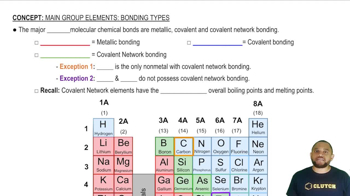Write Lewis structures for each molecule or ion. Use expanded octets as necessary. a. PF5
Ch.10 - Chemical Bonding I: The Lewis Model
Chapter 10, Problem 85b
Order these compounds in order of decreasing carbon–carbon bond length: HCCH, H2CCH2, H3CCH3.
 Verified step by step guidance
Verified step by step guidance1
Identify the type of carbon-carbon bond in each compound: HCCH has a triple bond, H_2CCH_2 has a double bond, and H_3CCH_3 has a single bond.
Recall that bond length is inversely related to bond order: the higher the bond order, the shorter the bond length.
Understand that a triple bond (HCCH) is shorter than a double bond (H_2CCH_2), which is shorter than a single bond (H_3CCH_3).
Arrange the compounds in order of decreasing bond length: start with the compound with the longest bond (single bond) and end with the shortest bond (triple bond).
The order of decreasing carbon-carbon bond length is: H_3CCH_3, H_2CCH_2, HCCH.

Verified Solution
Video duration:
1mWas this helpful?
Key Concepts
Here are the essential concepts you must grasp in order to answer the question correctly.
Bond Length
Bond length is the distance between the nuclei of two bonded atoms. In general, bond lengths vary depending on the type of bond (single, double, or triple) and the atoms involved. Shorter bonds typically indicate stronger interactions, while longer bonds suggest weaker interactions. Understanding bond length is crucial for comparing the structural characteristics of different compounds.
Recommended video:
Guided course

Average Bond Order
Types of Carbon Bonds
Carbon can form single, double, or triple bonds with other carbon atoms. Single bonds (as in alkanes) are the longest and weakest, while triple bonds (as in alkynes) are the shortest and strongest. The type of bond significantly influences the physical properties of the compound, including bond length. Recognizing these differences is essential for ordering compounds based on their carbon–carbon bond lengths.
Recommended video:
Guided course

Bonding Types
Hybridization
Hybridization is the concept of mixing atomic orbitals to form new hybrid orbitals that can accommodate bonding. In carbon compounds, sp, sp², and sp³ hybridizations correspond to triple, double, and single bonds, respectively. The hybridization state affects the geometry and bond lengths of the molecules. Understanding hybridization helps predict the bond lengths in the given compounds.
Recommended video:
Guided course

Hybridization
Related Practice
Textbook Question
539
views
Textbook Question
Write Lewis structures for each molecule or ion. Use expanded octets as necessary. b. AsF6-
534
views
Textbook Question
Order these compounds in order of increasing carbon–carbon bond strength: HCCH, H2CCH2, H3CCH3.
1441
views
Textbook Question
Which of the two compounds, H2NNH2 and HNNH, has the strongest nitrogen-nitrogen bond, and which has the shorter nitrogen-nitrogen bond.
1937
views
1
rank
Textbook Question
Hydrogenation reactions are used to add hydrogen across double bonds in hydrocarbons and other organic compounds. Use average bond energies to calculate ΔHrxn for the hydrogenation reaction. H2C=CH2(g) + H2(g) → H3C–CH3(g)
2668
views
1
rank
Textbook Question
Ethanol is a possible fuel. Use average bond energies to calculate ΔHrxn for the combustion of ethanol. CH3CH2OH(g) + 3 O2(g) → 2 CO2(g) + 3 H2O(g)
2906
views
